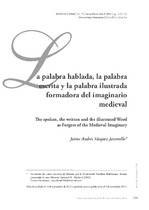Mostrar el registro sencillo del ítem
La palabra hablada, la palabra escrita y la palabra ilustrada formadora del imaginario medieval
| dc.contributor.author | Vásquez Jaramillo, Jaime Andrés | |
| dc.coverage.spatial | Seccional Medellín | spa |
| dc.date.accessioned | 2021-02-08T14:51:30Z | |
| dc.date.available | 2021-02-08T14:51:30Z | |
| dc.date.issued | 2012 | |
| dc.identifier.uri | http://hdl.handle.net/20.500.11912/7944 | |
| dc.description | p. 123 - 132 | spa |
| dc.description.abstract | El mundo medieval es comúnmente referido como un periodo de oscuridad frente la luminosidad de la razón. Pero no todo lo existente se siente a gusto con la luz, también las oscuridades guardan su propio mundo y realidad, haciéndose atractiva por aquello que parece ocultar. Solo aquellos que se aventuran a buscar pueden ver que las tinieblas tienen sus propias claridades. En estas oscuridades el hombre medieval se debatía en medio de dualidades, las cuales las experimentaba como complementariedad o como una forma alterna de entender, explicar y representar su realidad. Pero el miedo fue el principal mecanismo de control para inducir estos imaginarios. Esta tarea fue emprendida por autoridades como los reyes, los señores feudales y, sobre todo, por los clérigos medievales quienes tenían el acceso a la letra y al saber. Para poder difundir el temor estos últimos se valieron de la letra escrita (libros), hablada (sermones) e ilustrada (arte); de esta manera, controlaron los imaginarios y conformaron una sociedad según su pensar. Este artículo busca desentrañar cómo fue manipulado el imaginario medieval por medio del ejercicio del poder y, de manera especial, por la vía de la palabra hecha imagen en los textos y en el arte. | spa |
| dc.description.abstract | The medieval world is usually considered to be a period of darkness in contrast to the luminosity of reason. However, not everything that exists is comfortable with light; darkness has its own world and reality, having its own appeal because of what seems to be hiding. Only those who dare to search might be able to see that shadows have their own clarity. Within those shadows, the medieval man found himself between the extremes of some dualities, which he experienced as an alternative way of understanding, explaining and representing his reality. Nevertheless, fear was the main means of control used to create such imaginaries. This task was undertaken by the authorities of the time, such as kings, feudal lords and, mainly, by the medieval clergymen, who had access to written texts and, because of that, to knowledge. In order to spread fear, clergymen used written (books), spoken (preaching) and illustrated (art) words. Thus, they could control the imaginaries and configure a society according to their will. The following paper aims to study the way in which the medieval imaginary was manipulated through the exercise of power, mainly throughout words made image in texts and art. | spa |
| dc.format.mimetype | application/pdf | |
| dc.language.iso | spa | |
| dc.publisher | Universidad Pontificia Bolivariana | spa |
| dc.relation.ispartof | Pensamiento humanista | spa |
| dc.rights | Attribution-NonCommercial-NoDerivatives 4.0 International | * |
| dc.rights.uri | http://creativecommons.org/licenses/by-nc-nd/4.0/ | * |
| dc.subject | Imagen | spa |
| dc.subject | Control | spa |
| dc.subject | Palabra | spa |
| dc.subject | Imaginario | spa |
| dc.subject | Temor | spa |
| dc.subject | Image | spa |
| dc.subject | Control | spa |
| dc.subject | Word | spa |
| dc.subject | Imaginary | spa |
| dc.subject | Fear | spa |
| dc.title | La palabra hablada, la palabra escrita y la palabra ilustrada formadora del imaginario medieval | spa |
| dc.title.alternative | The spoken, the written and the illustrated Word as Forgers of the Medieval Imaginary | spa |
| dc.type | article | spa |
| dc.rights.accessRights | openAccess | spa |
| dc.type.hasVersion | publishedVersion | spa |
| dc.description.sectional | Medellín | spa |
| dc.identifier.instname | instname:Universidad Pontificia Bolivariana | spa |
| dc.identifier.reponame | reponame:Repositorio Institucional de la Universidad Pontificia Bolivariana | spa |
| dc.identifier.repourl | repourl:https://repository.unab.edu.co/ |
Ficheros en el ítem
Este ítem aparece en la(s) siguiente(s) colección(ones)
-
No. 9 (2012) [11]


